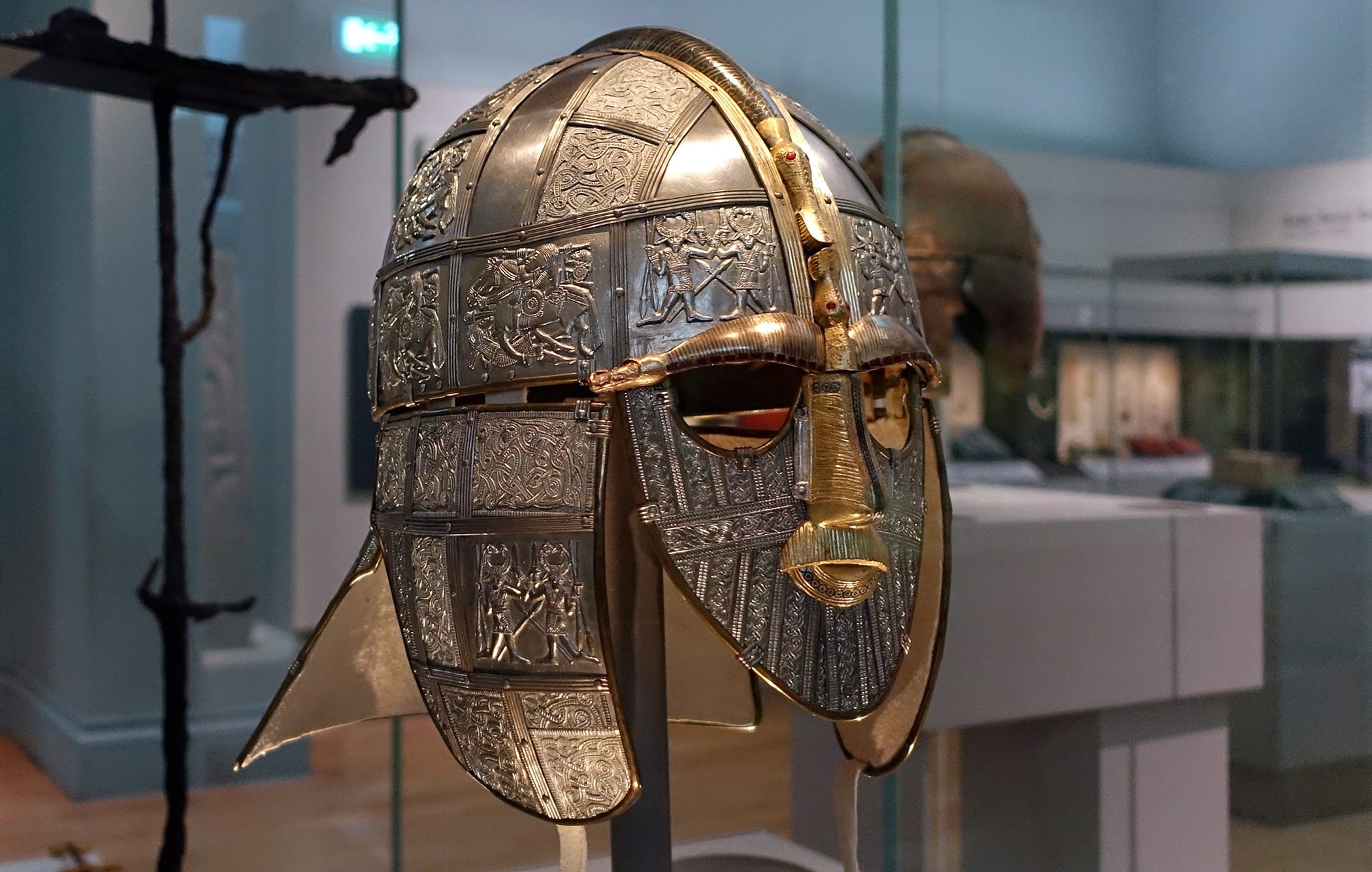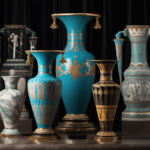Deep underground, an astonishing discovery lay hidden for centuries – the Sutton Hoo helmet. This remarkable artifact offers a captivating glimpse into the world of the Anglo-Saxons, a period marked by rich artistry, complex beliefs, and enduring mysteries. Unearthed in 1939, the Sutton Hoo helmet has since become an icon of Anglo-Saxon craftsmanship and a testament to the enduring power of cultural heritage. Let’s embark on a journey through time, exploring the intricate details, historical significance, and ongoing research that continue to unravel the secrets of this extraordinary find.
Facts About the Sutton Hoo Helmet
Picture this: the year is 1939, and archaeologists in England stumble upon an incredible sight – a ship burial laden with treasures from a bygone era. Among the riches, a helmet stands out, its grandeur practically radiating royalty. This, my friends, is the story of the Sutton Hoo helmet.
Crafted probably around 620-625 AD, the Sutton Hoo helmet is no ordinary battle gear. Imagine skilled Anglo-Saxon metalworkers meticulously hammering iron and applying thin sheets of bronze, creating intricate designs that continue to captivate us today. Swirling patterns, fierce beasts, and enigmatic scenes likely narrate stories or embody beliefs from that time.
Experts suggest that this helmet wasn’t merely for protection in battle. It likely served as a powerful symbol of authority, perhaps worn by a ruler like King Rædwald of East Anglia during important ceremonies. The impression it must have made, glinting under the sun, speaks volumes about the craftsmanship and artistry of the Anglo-Saxons.
Intriguingly, the Sutton Hoo helmet shares similarities with helmets discovered in other parts of Europe, particularly Scandinavia. This suggests a vibrant cultural exchange during that period, with different groups influencing each other’s art and traditions.
Yet, like any good mystery, the Sutton Hoo helmet retains some secrets. The exact meanings of its intricate designs continue to intrigue experts. What did these symbols represent to the Anglo-Saxons? What events did this helmet witness? Was it truly worn by King Rædwald himself?
Ongoing research offers hope for unlocking more of the helmet’s mysteries. It serves as a captivating window into the artistry, beliefs, and enigmatic world of the Anglo-Saxons, reminding us that there’s always something new to discover about the past.
How Many Helmets Were Found at Sutton Hoo?
When we consider the exceptional skill of Anglo-Saxon craftspeople, it’s remarkable to realize that we only have four complete helmets from their era. These helmets are like precious time capsules, each offering a unique glimpse into their ingenuity and the values they held dear.
Out of these four, the Sutton Hoo helmet stands as a true masterpiece. It’s not just a helmet; it’s a work of art that provides a window into the craftsmanship, beliefs, and burial rituals of this fascinating culture that we’re still piecing together.
What distinguishes this particular helmet? Imagine this: it’s adorned with intricate carvings and shimmering tinned bronze, making a bold statement about power and authority that goes beyond simple battlefield protection. Its discovery near the head of the deceased in the Sutton Hoo ship burial further emphasizes its significance as a highly prized possession in Anglo-Saxon society.
When the helmet came to light in the early 20th century, its discovery sent ripples of astonishment through the archaeological community. Its intricate designs, from swirling patterns to mythical creatures, resemble a visual feast, captivating historians and art enthusiasts alike. The Sutton Hoo helmet has become a crucial element in understanding the interplay between Anglo-Saxon culture and other societies, especially those in Scandinavia.
Importantly, the helmet was not found intact. Over 500 fragments, scattered within the collapsed burial chamber, awaited rediscovery. A team of exceptionally patient and skilled conservators dedicated themselves to the monumental task of piecing the helmet back together. This intricate, 3D jigsaw puzzle serves as a testament to the importance of preserving our shared history and the dedication required to do so.
While the identity of the helmet’s owner remains a subject of ongoing debate, most scholars believe it belonged to a high-ranking Anglo-Saxon leader, with King Rædwald of East Anglia being a prominent contender. The sheer craftsmanship of the helmet, coupled with its placement within the burial site, suggests it belonged to someone of great significance.
More than just a historical artifact, the Sutton Hoo helmet embodies human skill, artistic expression, and the enduring power of cultural heritage. It reminds us of the vast knowledge yet to be gleaned from the past and the exciting prospect of new discoveries waiting to be unearthed.
What Happened to the Sutton Hoo Helmet?
The Sutton Hoo helmet, unearthed in 1939, continues to fascinate with its elaborate designs and remarkable preservation. It begs the question: who created this masterpiece and what did it signify to them?
This wasn’t just any helmet. Its adornment with warriors, animal motifs, and potentially mythical scenes suggests a significance that transcended mere protection in battle. Imagine a king or a distinguished warrior donning this helmet during ceremonies – a powerful symbol of their status and authority.
Let’s recap what makes this helmet so special:
- It’s one of only four complete Anglo-Saxon helmets ever discovered, making it exceptionally rare.
- The craftsmanship is phenomenal, and its decorations hint at its potential use in both battle and ceremonial contexts as a symbol of power.
- Its discovery in the Sutton Hoo ship burial provides invaluable clues about Anglo-Saxon burial rituals and the impressive skills of their craftspeople.
- The fact that experts were able to painstakingly reassemble it after centuries of damage highlights the importance of preserving these ancient treasures for generations to come.
Speaking of its reconstruction, the helmet’s journey after being unearthed is a testament to the dedication of conservation experts. The burial chamber’s partial collapse over the centuries had left the helmet fragmented. However, a team of highly skilled conservators took on the challenge, meticulously piecing it back together like an incredibly complex 3D jigsaw puzzle. Their efforts underscore the knowledge and precision required to safeguard these delicate pieces of history.
Today, the Sutton Hoo helmet resides safely in the British Museum, where people from around the globe can marvel at its beauty and historical significance. It stands as a powerful reminder of the artistry and culture of the Anglo-Saxons, offering a glimpse into their beliefs, rituals, and values.
What is the Symbol on the Sutton Hoo Helmet?
While we’ve touched upon the magnificence of the Sutton Hoo helmet, let’s delve into the intricacies of its captivating designs. It’s as if the Anglo-Saxons sought to communicate a story without words, and what a story it is!
Take, for instance, the figures of warriors, parading around the helmet’s surface. One interpretation suggests they symbolize the wearer, perhaps a high-ranking figure or even a king, marching into battle – a truly intimidating sight! Then there are the snakes, weaving their way across the helmet. While snakes might evoke a sense of unease today, in many cultures, they represent wisdom and protection. Think of them as the helmet’s own personal guardians, warding off both negative energy and physical threats.
And we can’t overlook the birds, calmly perched amidst the scenes of battle and mythical creatures. Some scholars propose that these feathered beings might represent the soul’s journey, perhaps even alluding to the afterlife. It’s as though the Anglo-Saxons were conveying a message: “Yes, we are warriors, but we acknowledge a greater purpose and the mysteries that lie beyond.”
Adding a layer of intrigue, some historians believe these scenes could depict events from Beowulf, the epic Anglo-Saxon poem about heroes and monsters. Imagine, this helmet potentially serving as a visual representation of their favorite legend! Now, that’s a conversation starter.
Of course, with an artifact over 1,300 years old, definitive interpretations remain elusive. However, that is part of what makes the Sutton Hoo helmet so captivating. It’s a tantalizing puzzle, each detail we uncover bringing us closer to understanding the minds of the Anglo-Saxons. Who knows what other secrets this helmet holds? We can only hope that one day we’ll unravel its complete narrative. Until then, we revel in the speculation, marveling at the skill and artistry of these ancient craftspeople.
What Animals are on the Sutton Hoo Helmet?
While the Sutton Hoo helmet is renowned for its intricate design, you won’t find depictions of familiar animals like lions, tigers, or bears. Instead, it primarily features human figures, mythical creatures, and those mesmerizing knot-like patterns found in ancient manuscripts.
The absence of readily identifiable animals hasn’t dampened the helmet’s allure. In fact, some experts believe this could be a significant clue to its purpose. Was it strictly intended for battle, or might it have served a ceremonial role, signifying power and prestige? The debate continues, adding another layer of intrigue to this already fascinating artifact.
What are Some Interesting Facts about the Sutton Hoo Helmet?
We’ve only scratched the surface of what makes the Sutton Hoo helmet so extraordinary. This isn’t merely an old relic; it’s a portal to a different world.
- Fit for a King (Probably): Can you imagine the impression of arriving at a feast wearing this helmet? Its exquisite craftsmanship and opulent design strongly suggest it belonged to someone of great importance, perhaps even a king. The leading theory points to King Rædwald of East Anglia, who died around 625 AD. The helmet’s adornment with over 4,000 garnets certainly speaks to a regal aesthetic!
- Anglo-Saxon Craftsmanship at its Finest: The Sutton Hoo helmet wasn’t hastily cobbled together. It’s a masterpiece, meticulously crafted from iron and bronze. Its decorations, featuring mythical creatures, human figures, and intricate patterns, are a testament to the skill and artistry of Anglo-Saxon craftspeople. It’s as though the artist sought to include every element of wonder from their world.
- A Cultural Mashup: The Sutton Hoo helmet might be an early example of cultural fusion. It showcases a blend of Anglo-Saxon and Scandinavian styles, suggesting interconnectedness between these cultures. It’s like the ultimate souvenir from a cultural exchange.
- More Than Just a Pretty Face: While undeniably a work of art, the helmet was also designed for battle. Its sturdy construction, complete with a face mask and cheek pieces, speaks to its practicality in warfare. This offers us insight into Anglo-Saxon approaches to combat and protection.
- A National Treasure (and Rightfully So!): The discovery of the Sutton Hoo helmet in 1939 sent shockwaves through the archaeological world. It was like unearthing a treasure chest filled with clues to the past. Today, it is considered one of Britain’s most significant artifacts and is proudly displayed in the British Museum.
Still Curious? Research on the Sutton Hoo helmet and its mysteries is ongoing. Who commissioned it? What do all the symbols truly mean? Each new discovery brings us closer to understanding this captivating piece of history. If you ever find yourself in London, be sure to pay it a visit – you won’t be disappointed.
How Old is the Sutton Hoo Helmet?
The Sutton Hoo helmet, discovered in a ship burial in 1939, serves as a tangible link to the past. This remarkable artifact provides insights into the artistry and skill of the Anglo-Saxons. But just how old is this iconic helmet?
Experts believe it dates back roughly 1,400 years, placing its creation sometime in the early 7th century. That means this helmet has witnessed nearly 14 centuries of history! It’s a humbling thought, imagining all that has transpired during its existence.
The helmet’s intricate design and use of precious materials suggest it belonged to someone of high status, possibly a king or a powerful warrior. Some historians even believe it might have been worn by King Rædwald of East Anglia himself!
While many theories surround the helmet and the other treasures found in the burial mound, not every detail is certain. There’s a sense of excitement in that uncertainty. Archaeology is like a giant puzzle, with each new discovery fitting into a larger picture of the past.
Were Any Skeletons Found at Sutton Hoo?
One of the most intriguing aspects of the Sutton Hoo ship burial is the curious absence of any skeletal remains. Imagine: a burial chamber fit for a king, overflowing with treasures, yet devoid of its intended occupant. This puzzling detail has fueled debate among historians for decades.
There are two main schools of thought on this issue. Some experts believe the Sutton Hoo site might be what is known as a “cenotaph” – a monument or empty tomb erected in honor of a person or group of people buried elsewhere. This type of symbolic burial site could explain the presence of such lavish grave goods without a body. The existence of a human-sized space within the burial chamber, as if someone should be there, lends credence to this theory.
Another theory posits that the highly acidic soil at Sutton Hoo could be responsible for the lack of skeletal remains. Over centuries, acidic soil can decalcify bones, causing them to deteriorate and eventually disappear completely. It’s a less glamorous explanation, perhaps, but certainly plausible given the passage of time.
Ultimately, the reason for the missing skeleton at Sutton Hoo remains a mystery. And it’s a mystery that continues to fascinate! Scientists and archaeologists are still researching, analyzing, and debating, searching for clues that might provide a definitive answer. Until then, the intriguing puzzle of the missing Sutton Hoo skeleton endures.
How Many Artifacts Were Found at Sutton Hoo?
Imagine stumbling upon a time capsule, buried centuries ago, brimming with insights into a lost civilization. This is precisely what transpired at Sutton Hoo in 1939! Instead of a capsule, they unearthed an entire ship, its interior laden with over two hundred objects! Weapons that would make a warrior envious, shimmering jewelry fit for royalty, and even everyday items like spoons and bowls. To be precise, the excavation at Sutton Hoo revealed an astonishing 263 artifacts – each one a piece of the puzzle, helping us to understand the Anglo-Saxons.
You might think 263 objects doesn’t sound like a significant number. But imagine trying to understand someone’s life by looking at 263 random items from their home. That’s what makes the Sutton Hoo discovery so incredible.
These weren’t just ordinary possessions; they were carefully crafted, valuable pieces, suggesting the individual buried there was someone of immense importance. We’re talking about a high-status individual, potentially a king! Every sword, every gold buckle, every single coin whispered tales of wealth, power, and the artistry of the Anglo-Saxons.
Each artifact required painstaking excavation, careful cleaning, and meticulous cataloging by archaeologists like Basil Brown. This delicate, time-consuming process has provided a priceless window into the past.
And the research continues! Experts are still examining the Sutton Hoo artifacts using cutting-edge technology to uncover even more secrets. Who knows what other remarkable discoveries await?
Why is the Sutton Hoo Helmet Not at the Dig Site?
We’ve discussed the wonders found at Sutton Hoo, and you’ve likely seen pictures of the iconic helmet. However, you won’t find it displayed at the excavation site.
The reason is simple: preservation. The helmet is incredibly old and fragile. Leaving it exposed to the elements would be like leaving a priceless painting out in the rain! To ensure its protection, the helmet has a special home – the British Museum. This controlled environment allows experts to monitor its condition, prevent deterioration, and study it with specialized equipment.
Furthermore, displaying the helmet in the museum makes it accessible to people from all over the world. It provides a unique opportunity for anyone to marvel at its craftsmanship and connect with its history.
But the research doesn’t stop there! Archaeologists continue to investigate the Sutton Hoo site, hoping to uncover more about the helmet’s role in Anglo-Saxon society. Was it strictly ceremonial? Did it belong to King Rædwald, or someone else entirely? These are just some of the questions researchers are working to answer.
So, while the helmet might not be physically present at the dig site, its presence is keenly felt. It’s a constant source of fascination and a reminder of the rich history buried beneath our feet. Who knows what other secrets about the Sutton Hoo helmet future excavations might reveal?
How Much is the Sutton Hoo Treasure Worth Today?
It’s impossible to put an exact price tag on something as historically and culturally significant as the Sutton Hoo treasure. It’s never been up for sale, so we don’t have an auction price to use as a reference point. Could you even put a value on something so intricately connected to our shared past?
Consider the Sutton Hoo helmet – a celebrity in the world of archaeology. It’s a masterpiece that embodies the incredible skill and artistry of the Anglo-Saxons. The time and dedication required to create such a detailed and elaborate helmet render it priceless.
It’s also important to remember the context of its discovery. The burial site is believed to have belonged to a powerful king from East Anglia, adding another layer of intrigue and historical value to the find.
The true worth of the Sutton Hoo treasure transcends monetary value. This collection of artifacts is a time capsule, offering a glimpse into the world of the Anglo-Saxons. We learn about their culture, their craftsmanship, their societal structures – all through these remarkable objects.
Therefore, while we may never know the “market value” of the Sutton Hoo treasure, it’s safe to say it’s priceless. Its historical, artistic, and cultural significance renders it an invaluable piece of our shared heritage.
- Unveiling Bernhard Caesar Einstein’s Scientific Achievements: A Legacy in Engineering - July 15, 2025
- Uncover who is Jerry McSorley: CEO, Family Man, Business Success Story - July 15, 2025
- Discover Bernhard Caesar Einstein’s Scientific Contributions: Unveiling a Legacy Beyond Einstein - July 15, 2025















